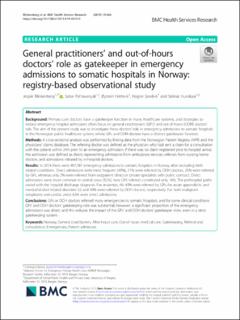| dc.description.abstract | Background
Primary care doctors have a gatekeeper function in many healthcare systems, and strategies to reduce emergency hospital admissions often focus on general practitioners’ (GPs’) and out-of-hours (OOH) doctors’ role. The aim of the present study was to investigate these doctors’ role in emergency admissions to somatic hospitals in the Norwegian public healthcare system, where GPs and OOH doctors have a distinct gatekeeper function.
Methods
A cross-sectional analysis was performed by linking data from the Norwegian Patient Registry (NPR) and the physicians’ claims database. The referring doctor was defined as the physician who had sent a claim for a consultation with the patient within 24 h prior to an emergency admission. If there was no claim registered prior to hospital arrival, the admission was defined as direct, representing admissions from ambulance services, referrals from nursing home doctors, and admissions initiated by in-hospital doctors.
Results
In 2014 there were 497,587 emergency admissions to somatic hospitals in Norway after excluding birth related conditions. Direct admissions were most frequent (43%), 31% were referred by OOH doctors, 25% were referred by GPs, whereas only 2% were referred from outpatient clinics or private specialists with public contract. Direct admissions were more common in central areas (52%), here GPs’ referrals constituted only 16%. The prehospital paths varied with the hospital discharge diagnosis. For anaemias, 46–49% were referred by GPs, for acute appendicitis and mental/alcohol related disorders 52 and 49% were referred by OOH doctors, respectively. For both malignant neoplasms and cardiac arrest 63% were direct admissions.
Conclusions
GPs or OOH doctors referred many emergencies to somatic hospitals, and for some clinical conditions GPs’ and OOH doctors’ gatekeeping role was substantial. However, a significant proportion of the emergency admissions was direct, and this reduces the impact of the GPs’ and OOH doctors’ gatekeeper roles, even in a strict gatekeeping system. | |

